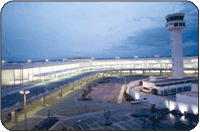Eyes BOT for the Project
May 10,2010
 Manila - Manila International Airport Authority (MIAA) has announced its plan to expand the current centennial terminal (Terminal 2) to Nayong Pilipino by 2014 to anticipate the projected increase in passenger traffic to the Philippines premiere airport by 2016 says Melvin Matibag, MIAA General Manager.
Manila - Manila International Airport Authority (MIAA) has announced its plan to expand the current centennial terminal (Terminal 2) to Nayong Pilipino by 2014 to anticipate the projected increase in passenger traffic to the Philippines premiere airport by 2016 says Melvin Matibag, MIAA General Manager.The airport which currently handles more than 24 million passengers from four terminals is projected to breach maximum capacity of 35 million passengers per year by 2016 adds Matibag.
"The planned Terminal 2 extension could house the low-cost carriers' operations and possibly cargo services" says Matibag in a press briefing.
The plan according to him is to transfer the operations of the low cost carriers to Terminal 2 and relocate the operations of Philippine Airlines to Terminal 3 together with other foreign carriers going to the east.
He however discussed the possibility of usage by current Terminal 2 tenant, Philippine Airlines which has been operating at the terminal close to its maximum design capacity of 10 million passengers per year.
The centennial terminal has a current capacity of 7 million passengers per year. But Philippine Airlines already breached its capacity in 2007, and still the airline is expected to add one million more passengers this year from the current 9.3 million passengers it carried in 2009 based on Civil Aeronautics Board(CAB) figures. It already transferred the operations of its low cost subsidiary Air Philippines and Pal Express to Terminal 3 since it opened in 2008 to help alleviate congestion at the terminal.
"Based on international standards, terminal two is already congested and we need to address that problem soon,"
"By 2014, Terminal two could be serving 14 million passengers or almost twice its intended capacity unless we do something" said Matibag.
"To do the expansion we need to acquire first the lot of the adjacent Nayong Pilipino which owns the land to which the Philippine Village Hotel now stands." Matibag adds.
While both institutions are all owned by the government, Nayong Pilipino Foundation is a government owned and controlled corporation which has a separate corporate identity from Manila International Airport Authority.
The extension project of Centennial Terminal 2 has been deferred for five years because of the litigation involving Nayong Pilipino and owners of Philippine Village Hotel. PAL offered to build the extension in 2007 but was hampered by the legal dispute at Nayong Pilipino. The Supreme Court recently upheld in January 2009 the lower courts order terminating the lease contract executed in 1975 for default lease payment in 2001. The hotel building was also forfeited in favor of Nayong Pilipino which it now controls.
Atty. Matibag said that the village hotel building is planned to be incorporated in the design of the expanded terminal 2 complex. The construction work is expected to be undertaken through build-operate-transfer (BOT) scheme.
“Right now, we are merely leasing one hectare of their property and we are using that space for parking,” said Matibag.
Currently, the Department of Transportation and Communication (DOTC) is looking into the legal aspect of the agency’s intention to acquire the rest of the property and the terms of the BOT contract to avoid a repeat of the terminal 3 fiasco.
Nayong Pilipino executive director Charito Planas revealed that negotiations were already undertaken between the two agencies as to the terms of reference (TOR) as the transaction merely require the approval of the President of the Philippines, but left the technical details of the talk to the panel preparing its approval.
According to Executive Order 615 issued on April 15, 2007, the park’s 15 hectare property adjacent to Terminal 2 in Pasay City is set to be transferred to Philippine Reclamation Authority (PRA) in exchange for equivalent size lot at the reclamation area to be used for construction of the new Nayong Pilipino Complex in Parañaque City.
MIAA expects to generate P1.6 billion pesos in net revenue for 2010 from operating four terminals. It already recorded a net income of P410 million in the first quarter of the year, higher by 4 percent as compared to the P394 million posted in 2009.
The airport also expects to collect P2.8 billion pesos from 26 million passengers. Revenues from passenger-terminal fees already jumped 13 percent to P702 million in the first three months of the year. Security related charges also increased 13 percent to P216 million due to the more international departures as compared last year.
International-passenger movement improved nearly 10 percent to 3,084,303 in the first quarter compared to the same period last year, while domestic passenger movements increased by almost 14 percent to 3,379,761 during the period.
Meanwhile, the airports rental revenues and concessions privilege fees grew almost flat at P294 million and P151 million, respectively due to still unresolved issues at terminal 3, while aeronautical fees declined 4 percent to P494 million due to foreign exchange losses.
One good thing about Terminal 3 is that passenger numbers went up by 15 percent to 1,737,451 in the first quarter while flight movement grew almost 8 percent to 16,468 during the period.
Its current tenant, Cebu Pacific expects to carry 10 million passengers in 2010. The new terminal has an annual design capacity of 13 million passengers with 20 million passengers as its maximum accommodation per year.
Terminal 3 boast of 20 contact gates and eight remote stands while Terminal 2 on the other hand only have 12 contact gates and 2 remotes.
No comments:
Post a Comment